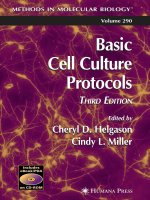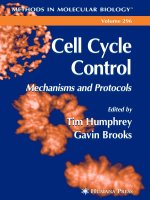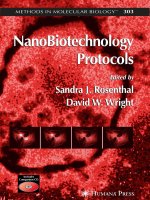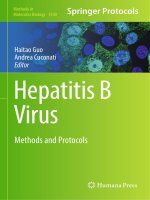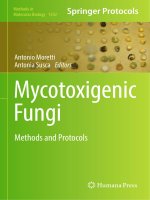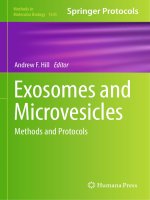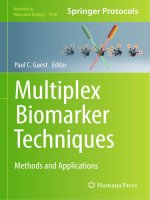- Trang chủ >>
- Khoa Học Tự Nhiên >>
- Vật lý
methods in molecular biology, v.303. nanobiotechnology protocols, 2005, p.242
Bạn đang xem bản rút gọn của tài liệu. Xem và tải ngay bản đầy đủ của tài liệu tại đây (4.49 MB, 242 trang )
Edited by
Sandra J. Rosenthal
David W. Wright
NanoBiotechnology
Protocols
METHODS IN MOLECULAR BIOLOGY
™
303
Edited by
Sandra J. Rosenthal
David W. Wright
NanoBiotechnology
Protocols
NanoBiotechnology Protocols
M E T H O D S I N M O L E C U L A R B I O L O G Y
™
John M. Walker, SERIES EDITOR
316. Bioinformatics and Drug Discovery, edited by
Richard S. Larson, 2005
315. Mast Cells: Methods and Protocols, edited by Guha
Krishnaswamy and David S. Chi, 2005
314. DNA Repair Protocols: Mammalian Systems, Second
Edition, edited by Daryl S. Henderson, 2005
313. Yeast Protocols: Second Edition, edited by Wei Xiao,
2005
312. Calcium Signaling Protocols: Second Edition, edited
by David G. Lambert, 2005
311. Pharmacogenomics: Methods and Applications, edited
by Federico Innocenti, 2005
310. Chemical Genomics: Reviews and Protocols, edited by
Edward D. Zanders, 2005
309. RNA Silencing: Methods and Protocols, edited by
Gordon Carmichael, 2005
308. Therapeutic Proteins: Methods and Protocols,
edited by C. Mark Smales and David C. James, 2005
307.Phosphodiesterase Methods and Protocols,
edited by Claire Lugnier, 2005
306. Receptor Binding Techniques: Second Edition,
edited by Anthony P. Davenport, 2005
305.Protein–Ligand Interactions: Methods and
Protocols,
edited by G. Ulrich Nienhaus, 2005
304. Human Retrovirus Protocols:
Virology and
Molecular Biology,
edited by Tuofu Zhu, 2005
303. NanoBiotechnology Protocols
,
edited by Sandra J.
Rosenthal and David W. Wright, 2005
302. Handbook of ELISPOT: Methods and Protocols
,
edited by Alexander E. Kalyuzhny, 2005
301. Ubiquitin–Proteasome Protocols,
edited by
Cam Patterson and Douglas M. Cyr, 2005
300. Protein Nanotechnology: Protocols,
Instrumenta
tion, and Applications, edited by
Tuan Vo-Dinh, 2005
299. Amyloid Proteins: Methods and Protocols,
edited by Einar M. Sigurdsson, 2005
298. Peptide Synthesis and Application,
edited by
John Howl, 2005
297. Forensic DNA Typing Protocols,
edited by
Angel Carracedo, 2005
296. Cell Cycle Protocols, edited by Tim Humphrey
and Gavin Brooks, 2005
295. Immunochemical Protocols, Third Edition,
edited by Robert Burns, 2005
294. Cell Migration: Developmental Methods and
Protocols, edited by Jun-Lin Guan, 2005
293. Laser Capture Microdissection: Methods and
Protocols, edited by Graeme I. Murray and
Stephanie Curran, 2005
292. DNA Viruses: Methods and Protocols, edited by
Paul M. Lieberman, 2005
291. Molecular Toxicology Protocols, edited by
Phouthone Keohavong and Stephen G. Grant, 2005
290. Basic Cell Culture, Third Edition, edited by
Cheryl D. Helgason and Cindy Miller, 2005
289. Epidermal Cells, Methods and Applications,
edited by Kursad Turksen, 2005
288. Oligonucleotide Synthesis, Methods and Appli-
cations, edited by Piet Herdewijn, 2005
287. Epigenetics Protocols, edited by Trygve O.
Tollefsbol, 2004
286. Transgenic Plants: Methods and Protocols,
edited by Leandro Peña, 2005
285. Cell Cycle Control and Dysregulation Protocols:
Cyclins, Cyclin-Dependent Kinases, and Other Fac-
tors, edited by Antonio Giordano and Gaetano
Romano, 2004
284. Signal Transduction Protocols, Second Edition,
edited by Robert C. Dickson and Michael D.
Mendenhall, 2004
283. Bioconjugation Protocols, edited by Christof
M. Niemeyer, 2004
282. Apoptosis Methods and Protocols, edited by
Hugh J. M. Brady, 2004
281. Checkpoint Controls and Cancer, Volume 2:
Activation and Regulation Protocols, edited by
Axel H. Schönthal, 2004
280. Checkpoint Controls and Cancer, Volume 1:
Reviews and Model Systems, edited by Axel H.
Schönthal, 2004
279. Nitric Oxide Protocols, Second Edition, edited
by Aviv Hassid, 2004
278. Protein NMR Techniques, Second Edition,
edited by A. Kristina Downing, 2004
277. Trinucleotide Repeat Protocols, edited by
Yoshinori Kohwi, 2004
276. Capillary Electrophoresis of Proteins and
Peptides, edited by Mark A. Strege and
Avinash L. Lagu, 2004
275. Chemoinformatics, edited by Jürgen Bajorath, 2004
274. Photosynthesis Research Protocols, edited by
Robert Carpentier, 2004
273. Platelets and Megakaryocytes, Volume 2:
Perspectives and Techniques, edited by
Jonathan M. Gibbins and Martyn P. Mahaut-
Smith, 2004
272. Platelets and Megakaryocytes, Volume 1:
Functional Assays, edited by Jonathan M.
Gibbins and Martyn P. Mahaut-Smith, 2004
271. B Cell Protocols, edited by Hua Gu and Klaus
Rajewsky, 2004
270. Parasite Genomics Protocols, edited by Sara
E. Melville, 2004
269. Vaccina Virus and Poxvirology: Methods and
Protocols,edited by Stuart N. Isaacs, 2004
268. Public Health Microbiology: Methods and
Protocols, edited by John F. T. Spencer and
Alicia L. Ragout de Spencer, 2004
M E T H O D S I N M O L E C U L A R B I O L O G Y
™
NanoBiotechnology
Protocols
Edited by
Sandra J. Rosenthal
and
David W. Wright
The Department of Chemistry, Vanderbilt University,
Nashville, TN
© 2005 Humana Press Inc.
999 Riverview Drive, Suite 208
Totowa, New Jersey 07512
www.humanapress.com
All rights reserved. No part of this book may be reproduced, stored in a retrieval system, or transmitted in
any form or by any means, electronic, mechanical, photocopying, microfilming, recording, or otherwise
without written permission from the Publisher. Methods in Molecular Biology
TM
is a trademark of The
Humana Press Inc.
All papers, comments, opinions, conclusions, or recommendations are those of the author(s), and do not
necessarily reflect the views of the publisher.
This publication is printed on acid-free paper. ∞
ANSI Z39.48-1984 (American Standards Institute)
Permanence of Paper for Printed Library Materials.
Production Editor: C. Tirpak
Cover design by Patricia F. Cleary
Cover Illustration: From Fig. 2, Chapter 1, "Applications of Quantum Dots in Biology: An Overview," by
Charles Z. Hotz and from Fig. 3, Chapter 13, "Nanostructured DNA Templates," by Jeffery L. Coffer,
Russell F. Pnizzotto, and Young Gyu Rho.
For additional copies, pricing for bulk purchases, and/or information about other Humana titles, contact
Humana at the above address or at any of the following numbers: Tel: 973-256-1699; Fax: 973-256-8341;
E-mail: ; or visit our Website: www.humanapress.com
Photocopy Authorization Policy:
Authorization to photocopy items for internal or personal use, or the internal or personal use of specific
clients, is granted by Humana Press Inc., provided that the base fee of US $30.00 per copy is paid directly
to the Copyright Clearance Center at 222 Rosewood Drive, Danvers, MA 01923. For those organizations
that have been granted a photocopy license from the CCC, a separate system of payment has been arranged
and is acceptable to Humana Press Inc. The fee code for users of the Transactional Reporting Service is:
[1-58829-276-2/05 $30.00 ].
Printed in the United States of America. 10 9 8 7 6 5 4 3 2 1
ISSN 1064-3745
E-ISBN 1-59259-901-X
Library of Congress Cataloging-in-Publication Data
Nanobiotechnology protocols / edited by Sandra J. Rosenthal and David W. Wright.
p. cm. (Methods in molecular biology ; 303)
Includes bibliographical references and index.
ISBN 1-58829-276-2 (alk. paper)
1. Nanotechnology Laboratory manuals. 2. Biotechnology Laboratory
manuals. I. Rosenthal, Sandra Jean, 1966- II. Wright, David W. III. Series:
Methods in molecular biology (Clifton, N.J.) ; 303.
TP248.25.N35N35 2005
660.6 dc22
2005000473
v
Preface
Increasingly, researchers find themselves involved in discipline-spanning
science that a decade ago was simply inconceivable. Nowhere is this more
apparent than at the cusp of two rapidly developing fields, nanoscience and
biotechnology. The resulting hybrid of nanobiotechnology holds the promise
of providing revolutionary insight into aspects of biology ranging from funda-
mental questions of receptor function to drug discovery and personal medi-
cine. As with many fields fraught with increasing hyperbole, it is essential that
the underlying approaches be based on solid, reproducible methods. It is the
goal of NanoBiotechnology Protocols to provide novice and experienced re-
searchers alike a cross-section of the methods employed in significant frontier
areas of nanobiotechnology.
In a rapidly developing field such as biotechnology, it is difficult to predict
at what mature endpoint a field will arrive. Today, nanobiotechnology is mak-
ing significant advances in three broad areas: novel materials synthesis,
dynamic cellular imaging, and biological assays. As a testament to the true
nature of interdisciplinary research involved in nanobiotechnology, each of
these areas is being driven by rapid advances in the others: New materials are
enabling the imaging of cellular processes for longer durations, leading to high-
throughput cellular-based screens for drug discovery, drug delivery, and diag-
nostic applications.
NanoBiotechnology Protocols addresses methods in each of these areas.
Two overview chapters are provided for perspective for those beginning inves-
tigations in nanobiotechnology. Throughout this volume, there is a deliberate
emphasis on the use of nanoparticles. As functionalized materials, they repre-
sent one of the fundamental enabling nanoscale components for these tech-
nologies. Consequently, many of the protocols highlight diverse strategies to
synthesize and functionalize these probes for biological applications. Other
chapters focus on the use of biological components (peptides, antibodies, and
DNA) to synthesize and organize nanoparticles to be used as building blocks in
larger assemblies. The methods described herein are by no means complete;
vi Preface
nor are they necessarily intended to be. Every day seems to produce new appli-
cations of nanotechnology to biological systems. It is our hope that this volume
provides a detailed, hands-on perspective of nanobiotechnology to encourage
scientists working in interdisciplinary fields to recognize the utility of this
emerging technology.
Sandra J. Rosenthal
David W. Wright
vii
Contents
Preface v
Contributors ix
Companion CD xii
1 Applications of Quantum Dots in Biology:
An Overview
Charles Z. Hotz 1
2 Fluoroimmunoassays Using Antibody-Conjugated
Quantum Dots
Ellen R. Goldman, Hedi Mattoussi, George P. Anderson,
Igor L. Medintz, and J. Matthew Mauro 19
3 Labeling Cell-Surface Proteins Via Antibody Quantum Dot
Streptavidin Conjugates
John N. Mason, Ian D. Tomlinson, Sandra J. Rosenthal,
and Randy D. Blakely 35
4 Peptide-Conjugated Quantum Dots:
Imaging the Angiotensin
Type 1 Receptor in Living Cells
Ian D. Tomlinson, John N. Mason, Randy D. Blakely,
and Sandra J. Rosenthal 51
5 Quantum Dot-Encoded Beads
Xiaohu Gao and Shuming Nie 61
6 Use of Nanobarcodes
®
Particles in Bioassays
R. Griffith Freeman, Paul A. Raju, Scott M. Norton,
Ian D. Walton, Patrick C. Smith, Lin He, Michael J. Natan,
Michael Y. Sha, and Sharron G. Penn 73
7 Assembly and Characterization of Biomolecule–Gold
Nanoparticle Conjugates and Their Use
in Intracellular Imaging
Alexander Tkachenko, Huan Xie, Stefan Franzen,
and Daniel L. Feldheim 85
8 Whole-Blood Immunoassay Facilitated by Gold
Nanoshell–Conjugate Antibodies
Lee R. Hirsch, Naomi J. Halas, and Jennifer L. West 101
9 Assays for Selection of Single-Chain Fragment Variable
Recombinant Antibodies to Metal Nanoclusters
Jennifer Edl, Ray Mernaugh, and David W. Wright 113
10 Surface-Functionalized Nanoparticles for Controlled
Drug Delivery
Sung-Wook Choi, Woo-Sik Kim, and Jung-Hyun Kim 121
11 Screening of Combinatorial Peptide Libraries
for Nanocluster Synthesis
Joseph M. Slocik and David W. Wright 133
12 Structural DNA Nanotechnology:
An Overview
Nadrian C. Seeman 143
13 Nanostructured DNA Templates
Jeffery L. Coffer, Russell F. Pinizzotto,
and Young Gyu Rho 167
14 Probing DNA Structure With Nanoparticles
Rahina Mahtab and Catherine J. Murphy 179
15 Synthetic Nanoscale Elements for Delivery of Materials
Into Viable Cells
Timothy E. McKnight, Anatoli V. Melechko,
Michael A. Guillorn, Vladimir I. Merkulov,
Douglas H. Lowndes, and Michael L. Simpson 191
16 Real-Time Cell Dynamics With a Multianalyte Physiometer
Sven E. Eklund, Eugene Kozlov, Dale E. Taylor,
Franz Baudenbacher, and David E. Cliffel 209
Index 224
viii Contents
ix
Contributors
GEORGE P. ANDERSON • Center for Bio/Molecular Science and Engineering
Naval Research Laboratory, Washington DC
F
RANZ BAUDENBACHER • Department of Physics, Vanderbilt University,
Nashville, TN
R
ANDY D. BLAKELY • Department of Pharmacology, Vanderbilt University
School of Medicine, Vanderbilt University, Nashville, TN
S
UNG-WOOK CHOI • Division of Chemical Engineering and Biotechnology,
Yonsei University, Seoul, Korea
D
AVID E. CLIFFEL • Department of Chemistry, Vanderbilt University,
Nashville, TN
J
EFFERY L. COFFER • Department of Chemistry, Texas Christian University,
Fort Worth, TX
J
ENNIFER EDL • Department of Biochemistry, Vanderbilt University,
Nashville, TN
S
VEN E. EKLUND • Department of Chemistry, Vanderbilt University,
Nashville, TN
D
ANIEL L. FELDHEIM • Department of Chemistry, North Carolina State
University, Raleigh, NC
S
TEFAN FRANZEN •Department of Chemistry, North Carolina State
University, Raleigh, NC
R. G
RIFFITH FREEMAN • Nanoplex Technologies Inc., Menlo Park, CA
X
IAOHU GAO • Departments of Biomedical Engineering, Chemistry,
Hematology and Oncology, Emory University, Atlanta, GA
W
ILHELM R. GLOMM • Department of Chemistry, North Carolina State
University, Raleigh, NC
E
LLEN R. GOLDMAN • Center for Bio/Molecular Science and Engineering
Naval Research Laboratory, Washington DC
M
ICHAEL A. GUILLORN • Molecular-Scale Engineering and Nanoscale
Technologies Research Group, Oak Ridge National Laboratory,
Oak Ridge, TN
x Contributors
NAOMI J. HALAS • Department of Electrical and Computer Engineering
and Department of Chemistry, Rice University Houston, TX
L
IN HE • Nanoplex Technologies Inc., Menlo Park, CA
L
EE R. HIRSCH • Department of Bioengineering, Rice University,
Houston, TX
C
HARLES Z. HOTZ • Quantum Dot Corporation, Hayward, CA
J
UNG-HYUN KIM •Nanosphere Process and Technology Laboratory, Yonsei
University, Seoul, Korea
W
OO-SIK KIM • Division of Chemical Engineering and Biotechnology,
Yonsei University, Seoul, Korea
E
UGENE KOZLOV • Department of Chemical Engineering, Vanderbilt
University, Nashville, TN
D
OUGLAS H. LOWNDES • Thin Film and Nanostructured Materials Physics
Group, Oak Ridge National Laboratory, Oak Ridge, TN
R
AHINA MAHTAB • Department of Physical Sciences, South Carolina State
University, Orangeburg, SC
J
OHN N. MASON • Department of Pharmacology, Vanderbilt University
School of Medicine, Vanderbilt University, Nashville, TN
H
EDI MATTOUSSI • Center for Bio/Molecular Science and Engineering Naval
Research Laboratory, Washington DC
J. M
ATTHEW MAURO • Center for Bio/Molecular Science and Engineering
Naval Research Laboratory, Washington DC
T
IMOTHY E. MCKNIGHT • Molecular-Scale Engineering and Nanoscale
Technologies Research Group, Oak Ridge National Laboratory,
Oak Ridge, TN
I
GOR L. MEDINTZ • Center for Bio/Molecular Science and Engineering Naval
Research Laboratory, Washington DC
A
NATOLI V. MELECHKO • Molecular-Scale Engineering and Nanoscale
Technologies Research Group, Oak Ridge National Laboratory,
Oak Ridge, Tennessee and Electrical and Computer Engineering
Department, University of Tennessee, Knoxville, TN
V
LADIMIR I. MERKULOV • Molecular-Scale Engineering and Nanoscale Tech-
nologies Research Group, Oak Ridge National Laboratory, Oak Ridge, TN
R
AY MERNAUGH • Department of Biochemistry Vanderbilt University,
Nashville, TN
C
ATHERINE J. MURPHY • Department of Chemistry and Biochemistry,
University of South Carolina, Columbia, SC
M
ICHAEL J. NATAN • Nanoplex Technologies Inc., Menlo Park, CA
S
HUMING NIE • Departments of Biomedical Engineering, Chemistry,
Hematology and Oncology, Emory University and Georgia Institute of
Technology, Atlanta, GA
SCOTT M. NORTON • Nanoplex Technologies Inc., Menlo Park, CA
S
HARRON G. PENN • Nanoplex Technologies Inc., Menlo Park, CA
R
USSELL F. PINIZZOTTO• Department of Physics, Merrimack College,
North Andover, MA
P
AUL A. RAJU • Nanoplex Technologies Inc., Menlo Park, CA
Y
OUNG GYU RHO • Department of Physics, University of North Texas,
Denton, TX
S
ANDRA J. ROSENTHAL • Department of Chemistry, Vanderbilt University,
Nashville, TN
J
OSEPH RYAN • Department of Chemistry, North Carolina State University,
Raleigh, NC
N
ADRIAN C. SEEMAN • Department of Chemistry, New York University,
New York, NY
M
ICHAEL Y. SHA • Nanoplex Technologies Inc., Menlo Park, CA
M
ICHAEL L. SIMPSON • Molecular-Scale Engineering and Nanoscale
Technologies Research Group, Oak Ridge National Laboratory, Oak
Ridge, Tennessee, Materials Science and Engineering Department
and Center for Environmental Biotechnology University of Tennessee,
Knoxville, TN
J
OSEPH M. SLOCIK • Department of Chemistry, Vanderbilt University,
Nashville, TN
P
ATRICK C. SMITH • Nanoplex Technologies Inc., Menlo Park, CA
D
ALE E. TAYLOR • Department of Chemistry, Vanderbilt University,
Nashville, TN
A
LEXANDER TKACHENKO • Department of Chemistry, North Carolina State
University, Raleigh, NC
I
AN D. TOMLINSON • Department of Chemistry, Vanderbilt University,
Nashville, TN
I
AN D. WALTON • Nanoplex Technologies Inc., Menlo Park, CA
J
ENNIFER L. WEST • Department of Bioengineering, Rice University,
Houston, TX
D
AVID W. WRIGHT • Department of Chemistry, Vanderbilt University,
Nashville TN
H
UAN XIE • Department of Chemistry, North Carolina State University,
Raleigh, NC
Contributors xi
Companion CD
To view color figures, please refer to the companion CD. The images are
best viewed on a high-resolution (1280 x 1280) color (24 bit or higher true
color) computer monitor.
xii
1
1
Applications of Quantum Dots in Biology
An Overview
Charles Z. Hotz
Summary
This chapter summarizes the properties of fluorescent semiconductor nanocrystals (quantum
dots), and their relationship to performance in biological assays. The properties of quantum dots
(optical, structural, compositional, etc.) are described. Recent work employing these entities
in biological studies (immunofluorescent labeling, imaging, microscopy in vivo applications,
encoding) is discussed.
Key Words
Quantum dot; semiconductor nanocrystal; labeling; biological imaging; immunohisto-
chemistry; fluorescence microscopy; multiplexing.
1. Introduction
Highly luminescent, colloidal semiconductor nanocrystals, or quantum dots,
have been known since the early 1990s (1–3); however, not until 1998 were
these materials were first utilized as biological probes (4,5). The emission wave-
length of these unique fluorescent probes can be altered with a change in the
size of the quantum dot, allowing their emission to be tuned to any wavelength
within a range determined by the semiconductor composition. Although there
have been a number of reports of biological applications of quantum dots since
the pioneering articles, it is clear that the use of these novel probes is still in its
infancy. Both protocols for using quantum dots and the methods for preparing
these reagents are continually being improved. Because many of the properties
of quantum dots differ from those of other fluorescent biological probes, quan-
tum dots can be enabling for a given application. These key properties are
discussed in relation to their performance in biological applications.
From: Methods in Molecular Biology, vol. 303: NanoBiotechnology Protocols
Edited by: S. J. Rosenthal and D. W. Wright © Humana Press Inc., Totowa, NJ
2. General Properties
2.1. Optical Properties
2.1.1. Absorbance Characteristics
Quantum dots absorb light differently than dye molecules. Fluorescent dyes
typically absorb light efficiently in an absorbance band that has a slightly
shorter wavelength than the emission (see Fig. 1A). This can be advantageous
for selective excitation of a fluorophore but also requires that each fluorescent
dye be excited separately when multiple colors are used together (multiplex).
This can decrease throughput and increase instrument cost, particularly when
lasers are required for excitation. The absorbance band of a fluorescent dye is
usually spectrally close to the light emitted, making efficient collection of the
emitted light more difficult owing to scatter, autofluorescence, and the need
for precise optical filters.
Quantum dots, by comparison, absorb light at all wavelengths shorter than
the emission (Fig. 1B). This allows multiple colors of quantum dots to be effec-
tively excited by a single source of light (e.g., lamp, laser, LED) far from the
emission of any color. The effective “Stokes shift,” or wavelength difference
between maximum absorbance and maximum emission (typically ~15–30 nm
for organic dyes), can be hundreds of nanometers for a quantum dot.
Not only can quantum dots be excited far from where they emit, but extinc-
tion coefficients (i.e., the measure of absorbed light) are much larger than
for typical fluorescent dyes and, thus, absorb light much more efficiently
(Fig. 1D). For example, the extinction coefficients for some common dyes
compared to quantum dots are provided in Table 1.
In addition, the use of many colors of quantum dots simultaneously (multi-
plexing) requires only one excitation source to excite all colors efficiently. This
can be particularly valuable in multicolor fluorescence microscopy, enabling
one to visualize simultaneously many colors of quantum dot-labeled probes.
2.1.2. Emission Characteristics
2.1.2.1. S
HAPE OF EMISSION SPECTRUM
By their nature, quantum dots exist in polydisperse collections of nanocrystals
of slightly different sizes. The emission spectrum of a solution of quantum dots
is the sum of the spectra of many individual quantum dots that differ slightly in
size. Consequently, the width of the observable emission spectrum depends on the
uniformity of the quantum dot size distribution (see Subheading 2.2.). A sample
that has a very uniform quantum dot size distribution will have a narrower
composite emission spectrum than a sample that is less uniform. Typically, the
size distribution is nearly normally distributed and the emission spectrum
nearly Gaussian shaped. This is in contrast to most fluorescent dyes that display
2 Hotz
asymmetric emission spectra that tail (sometimes dramatically) to the red (see
Fig. 1C). Additionally, typical high-quality quantum dot size distributions result
in emission spectrum widths (at half maximum) of 20–35 nm, which is notice-
ably narrower than for comparable dyes. These narrow, symmetric emission
Applications of Quantum Dots in Biology 3
Fig. 1. Comparison of absorbance and emission spectra (normalized) of (A) Alexa
®
568 streptavidin conjugate and (B) Qdot
®
605 streptavidin conjugate. Note that the
quantum dot conjugate can absorb light efficiently far to the blue of the emission.
(C) Comparison of emission spectra (nonnormalized) of streptavidin conjugates of
Qdot 605 ( ), Alexa 546 ( ), Alexa 568 ( ), and Cy3
®
( ). The spectra were taken
under conditions in which each fluorophore absorbed the same amount of excitation
light. The measured quantum yields of the conjugates were 55, 8, 16, and 11%, respec-
tively. (D) Comparison of absorbance spectra (nonnormalized, each 1 µM flurophore)
of Qdot 605 streptavidin conjugate ( ), Cy3 streptavidin conjugate ( ), Alexa 546
streptavidin conjugate ( ), and Alexa 568 streptavidin conjugate ( ). Note that all
dye spectra are enhanced fivefold for clarity. Alexa, Cy3, and Qdot are registered trade-
marks of Molecular Probes, Amersham Biosciences, and Quantum Dot Corporation,
respectively.
spectra make possible detection of multiple colors of quantum dots together (mul-
tiplexing) with low cross-talk between detection channels.
2.1.2.2. QUANTUM YIELD
Quantum yield is a measure of the “brightness” of a fluorophore and is
defined as the ratio of light emitted to light absorbed by a fluorescent material.
Some organic dyes have quantum yields approaching 100%, but conjugates
(from biological affinity molecules) made from these dyes generally have a
significantly lower quantum yield. Quantum dots retain their high quantum
yield even after conjugation to biological affinity molecules (Fig. 1C).
2.1.2.3. PHOTOSTABILITY
Fluorescent dyes tend to be organic molecules that are steadily bleached
(degraded) by the light used to excite them, progressively emitting less light
over time. Although a wide range of photostability is observed in various
4 Hotz
Table 1
Optical Properties of Quantum Dots Compared to Common Dyes
a
Fluorescent dye λ
excitation
(nm) λ
emission
(nm) ε(mol
–1
-cm
–1
)
Qdot 525 400 525 280,000
Alexa 488 495 519 78,000
Fluorescein 494 518 79,000
Qdot 565 400 565 960,000
Cy3 550 570 130,000
Alexa 555 555 565 112,000
Qdot 585 400 585 1,840,000
R-Phycoerythrin 565 578 1,960,000
TMR 555 580 90,000
Qdot 605 400 605 2,320,000
Alexa 568 578 603 88,000
Texas Red 595 615 96,000
Qdot 655 400 655 4,720,000
APC 650 660 700,000
Alexa 647 650 668 250,000
Cy5 649 670 200,000
Alexa 647-PE 565 668 1,960,000
a
The extinction coefficients (ε) are generally much larger for quantum dots than for fluores-
cent dyes. Furthermore, the excitation wavelength (λ
excitation
) can be much farther from the
emission (λ
emission
).
fluorescent dye molecules, the stability does not approach that observed in
quantum dots (see Fig. 2). Even under conditions of intense illumination (e.g.,
in a confocal microscope or flow cytometer), little if any degradation is
observed (6). This property makes quantum dots enabling in applications
requiring continuous observation of the probe (cell tracking, some imaging
applications, and so on), and potentially more valuable as quantitative reagents.
2.1.2.4. FLUORESCENCE LIFETIME
Quantum dots have somewhat longer fluorescence lifetimes than typical
organic fluorophores (approx 20–40 vs <5 ns, respectively) (7). While this
lifetime is shorter than “long-lifetime” fluorophores, such as lanthanides
(hundreds of microseconds), the difference could be exploited to reduce
autofluorescence background in some measurements, such as those made on
polymer substrates. A short delay between excitation and collection of the
emitted light can nearly eliminate autofluorescence of polymeric substrates
(or potentially other media such as blood) and still allow collection of the
majority of the quantum dot-emitted light (Quantum Dot Corporation, unpub-
lished data). Additionally, the relatively short lifetime of quantum dots does
not significantly reduce emission at high excitation power owing to saturation.
2.2. Physical Properties
2.2.1. Structure
Quantum dot conjugates are complex, multilayered structures, and many
process steps are required to produce a useful, biological conjugate (Fig. 3).
Some terminology that is used in describing quantum dot structures is as follows:
1. Core quantum dot: The central quantum dot nanocrystal, and what determines the
optical properties of the final structure. Most preparations produce core quantum
dots that are hydrophobic.
2. Core-shell quantum dot: Core nanocrystals that have a crystalline inorganic shell.
These materials are bright, stable, and, like cores, are hydrophobic and only sol-
uble in organic solvents.
3. Water-soluble quantum dot: Core-shell quantum dots that are hydrophilic and are
soluble in water and biological buffers. Commercially available water-soluble
quantum dots have a hydrophilic polymer coating.
4. Quantum dot bioconjugate: Coupling a water-soluble quantum dot to affinity mol-
ecules produces a quantum dot bioconjugate.
Unlike samples of dye molecules in which every molecule is identical, each
core quantum dot in a sample contains a slightly different number of atoms and
thus can be slightly different in some of the properties (see Subheading 2.3.).
Consequently, the methods developed to synthesize quantum dot cores are
Applications of Quantum Dots in Biology 5
Fig. 2. Comparison of photostability between Qdot
®
605 and Alexa Fluor
®
488 streptavidin conjugates. Actin filaments in two
3T3 mouse fibroblast cells were labeled with Qdot 605 streptavidin conjugate (red), and the nuclei were stained with Alexa Fluor
488 streptavidin (green). The specimens were continuously illuminated for 3 min with light from a 100-W mercury lamp under a
×100 1.30 oil objective. An excitation filter (excitation: 485 ± 20 nm) was used to excite both Alexa 488 and Qdot 605. Emission
filters (emission: 535 ± 10 and em 605 ± 10 nm) on a motorized filter wheel were used to collect Alexa 488 and Qdot 605 signals,
respectively. Images were captured with a cooled charge-coupled device camera at 10-s intervals for each color automatically.
Images at 0, 20, 60, 120, and 180 s are shown. Whereas Alexa 488 labeling signal faded quickly and became undetectable within
2 min, the Qdot 605 signal showed no obvious change for the entire 3-min illumination period.
continually being optimized to produce more uniform materials (8,9). This
increased uniformity of size and shape produces samples that have narrower
(sharper) emission spectra, allowing colors that are closer in wavelength (color)
to be used together.
Although these “core” quantum dots determine the optical properties of the
conjugate, they are by themselves unsuitable for biological probes owing to
their poor stability and quantum yield. In fact, the quantum yield of quantum
dot cores has been reported to be very sensitive to the presence of particular
ions in solution (10). Highly luminescent quantum dots are prepared by coat-
ing these core quantum dots with another material (in the case of cadmium
selenide cores, zinc sulfide or cadmium sulfide is generally used), resulting in
“core-shell” quantum dots that are much brighter, and more stable in various
chemical environments (3,11). These core-shell quantum dots are hydrophobic
and only organic soluble as prepared.
A number of methods have been reported to convert these hydrophobic
“core-shells” into aqueous-soluble, biologically useful versions (4,5,12,13).
Although a comprehensive comparison of these approaches does not exist,
there are significant differences in the stability and brightness, and therefore
the performance of the resulting aqueous materials. Frequently, investigators
do not report quantum yields of the bioconjugates prepared, and often the limit
of detection is not reported in a way that allows comparison of performance
with that of another method. The stability of the conjugate, a property that is
essential for a quantitative reagent, is generally not determined either. For
example, some preparations lack stability toward dilution (e.g., losing bright-
ness on dilution in buffer); other methods produce materials that exhibit
poor storage stability, or that become less bright in particular chemical envi-
ronments. High-quality, water-soluble quantum dots do not show significant
Applications of Quantum Dots in Biology 7
Fig. 3. Schematic of Qdot
™
Nanocrystal Probe compared to a typically labeled
fluorescent dye protein conjugate (see text for descriptions). Proteins generally carry
several fluorescent dye labels (F). By contrast, each quantum dot is conjugated to mul-
tiple protein molecules.
change in peak emission wavelength, or quantum yield, as a function of envi-
ronment or time.
Other than the difference in optical properties just outlined, quantum dots dif-
fer from dye conjugates in another important respect. Quantum dots are polyfunc-
tional; there are a number of affinity molecules (proteins, oligonucleotides, small
molecules, and so on) per quantum dot. In the case of traditional fluorescent
labels, there is generally a one-to-one correspondence of dye to small molecule,
and more than one dye molecule per protein or other large molecule (Fig. 3).
2.2.2. Size
Water-soluble quantum dot conjugates are in the 10 to 20-nm size range (as
measured by transmission electron microscopy, size-exclusion chromatogra-
phy, and dynamic light scattering), making them similar in size to large proteins
(see Fig. 4). This might preclude them from certain applications, however, their
size does not prevent use in the labeling of cell surfaces and tissue sections, or
from accessing intracellular targets in fixed and permeablized cells.
2.3. Material
A bulk (i.e., arbitrarily large) piece of semiconductor has a defined emis-
sion wavelength. When the size of the semiconductor particle is diminished to
the nanometer scale, “quantum confinement” becomes operant, and the emis-
sion wavelength becomes dependent on the particular particle size (hence, the
term quantum dot). Quantum confinement is due to the energy cost of confin-
ing the excited state (of an emitting quantum dot) to a smaller volume than it
would ideally occupy in the bulk material. Thus, smaller core quantum dots
are higher energy and emit “bluer” than larger ones. The useful consequence of
this property is that a range of colored fluorescent probes can be generated
from a single material simply by preparing different sizes of quantum dots.
The range of wavelengths within which a quantum dot can emit is determined
by the semiconductor core material.
Cadmium selenide is the material used in virtually all of the quantum dot bio-
logical labeling to date, and its emission spectrum conveniently spans the visible
light range (~450–660 nm). Materials such as cadmium telluride and indium
phosphide potentially allow probes in the far red (up to ~750 nm), and cadmium
sulfide and zinc selenide give access to the ultraviolet. Generation of far-red and
near-infrared (IR) quantum dot probes will likely be extremely valuable in whole-
blood assays in which absorption by hemoglobin limits the detection of shorter-
wavelength materials. Deep tissue and in vivo imaging are other areas in which
near-IR probes will find use, because scatter by tissue is minimized in this region
of the spectrum. A variety of semiconductor materials and the range of emission
wavelengths achievable by altering their size are shown in Fig. 5.
8 Hotz
3. Applications
3.1. Quantum Dots as Labels
For the purpose of this chapter, we define “labels” as single quantum dots
conjugated to biological affinity molecules (as differentiated from encoding
applications, described in Subheading 3.2.). These analogs to traditional fluo-
rescent dye-labeled proteins, antibodies, oligonucleotides, and so on can be
used in many biological applications, some of which are unique to quantum
dots. Most of the work published on quantum dot labels to date has been
“proof-of-concept” work—demonstrating the use of quantum dots in an appli-
cation, but typically not solving a particular biological problem. Furthermore,
the publications have used different or evolving preparations of quantum dots,
making results difficult to compare among investigators.
3.1.1. Immunohistochemistry and Other Microscope-Based Techniques
A standard fluorescence microscope is an ideal tool for detection of quantum
dot labels. Lamp-based excitation can be applied through a very wide excitation
filter for efficient excitation of the broad quantum dot excitation spectrum. Since
the emission spectrum is narrow, a narrow emission filter can be used to maxi-
mize signal to background. Alternatively, a long-pass emission filter can be used
to observe several colors simultaneously. Finally, the excellent photostability
provides additional time for focusing and sample inspection without bleaching.
Applications of Quantum Dots in Biology 9
Fig. 4. Physical size of quantum dots compared to related entities.
Wu et al. (6) successfully used quantum dots conjugated to immuno-
globulin G (IgG) and streptavidin to label the breast cancer marker Her2 on the
surface of cancer cells, stain actin and microtubule fibers in the cytoplasm, and
detect nuclear antigens. Labeling was shown to be specific for intended tar-
gets, brighter, and significantly more photostable than comparable organic dyes.
Using quantum dots of different colors conjugated to IgG and streptavidin, the
investigators detected two cellular targets with one excitation wavelength.
Although the number of simultaneously observable targets is limited in this
study, the number will increase as the number of available quantum dot colors
coupled to different affinity molecules increases.
Pathak et al. (14) used quantum dots coupled to oligonucleotides in in situ
hybridization. They successfully detected hybridization to the Y chromosome of
fixed human sperm cells, although no comparison was made to fluorescent dye
fluorescent in situ hybridization.
Quantum dots have been shown to be enabling in the area of multiphoton
microscopy (15). Quantum dot probes were reported to have the largest two-
photon cross-sections (a measure of the ability to absorb light at twice the
normal excitation wavelength) of any probe—close to the theoretical maximum
10 Hotz
Fig. 5. Wavelength ranges obtainable by varying size of quantum dots made from a
number of different semiconductor materials. Each bar approximately represents the
range of wavelengths obtained from the smallest (left end) to largest (right end) quan-
tum dot made from the material listed.
value. The cross-sections are 2 to 3 orders of magnitude larger than conven-
tional fluorescent probes now in use. With the use of two-photon imaging,
quantum dots were intravenously injected into mice and used to dynamically
visualize capillaries hundreds of microns deep through scattering media (skin
and adipose tissue).
3.1.2. Live Cell Labeling
Quantum dots have been used to label live cells. Jaiswal et al. (16) demon-
strated that a number of cell lines endocytosed quantum dots over a 2 to 3 h
period, and the quantum dots became localized in endosomes. These labeled
cells were shown to be stable for as long as 12 d in culture. The investigators
also labeled live cells by membrane biotinylation, followed by incubation with
quantum dot–avidin conjugate, although this method also resulted in quantum
dot endocytosis in the cell lines studied. They used the labeling procedure
to study the effect of starvation on aggregation of developing Dictyostelium
discoideum cells that were starved for various durations. Cells starved for dif-
ferent durations were labeled with different colored quantum dots, mixed, and
the labeled cells were imaged for 2-s intervals every 2 min for 8 h. It was con-
cluded that the cells’ propensity to aggregate is an “on-off” phenomenon, not
a continuous function of the degree of starvation. More generally, the work
represents the use of quantum dot labels to solve a new biological problem not
addressable by conventional fluorescent labeling.
Dubertret et al. (17) has reported the preparation of quantum dots function-
alized with polyethylene glycol (PEG) to study development in Xenopus
embryos. The quantum dots were microinjected into individual cells of the
growing embryo, and because the fluorescence was confined to the progeny of
the injected cells, this allowed the embryonic development to be studied for
many individual cells. It was found that the quantum dots were stable and had
little toxicity.
Quantum dots have also been used to measure cell motility by imaging of
phagokinetic tracks (18). It was demonstrated that cells were capable of engulf-
ing nanocrystals, through an undefined mechanism, as they travel, leaving
behind a history of their migratory track. Future research will explore the use
of the multiple emission colors of quantum dots to monitor cell motility and
migration and simultaneously track specific proteins tagged with complemen-
tary fluorescent probes.
3.1.3. In Vivo Applications
Several reports have appeared utilizing quantum dots in vivo. This work is
typically accomplished with fluorescent polymers, such as rhodamine green
Applications of Quantum Dots in Biology 11
dextran, or with fluorescent proteins, such as green fluorescent protein. The
lack of photostability and brightness of these reagents limits their utility in
longer-duration imaging experiments.
Akerman et al. (19) conducted specific targeting of quantum dot–peptide
bioconjugates in mice. Peptides that specifically target lung blood vessel endo-
thelial cells, tumor cell blood vessels, and tumor cell lymphatic vessels were
conjugated to quantum dots and intravenously injected into mice. Specific tar-
geting to the lung and tumor vasculature was observed with the appropriate
conjugates, and no acute toxicity was observed after 24 h of circulation. The
investigators also observed that the quantum dots accumulated in the liver and
spleen in addition to the targeted tissues, unless the quantum dot was coconju-
gated with PEG. While the quantum dot conjugates were specific for the tumor
targets, they did not accumulate in the tumor cells, instead remaining in the
blood vessel endothelia. The investigators speculated as to the possible causes:
the size of the quantum dots, the stability of the mercaptoacetic acid–stabilized
quantum dot conjugates used, or slow endocytosis into tumor cells.
3.1.4. Small-Molecule Conjugates
A limitation of traditional small-molecule fluorescent dyes is in the labeling
of other small molecules, drugs, transporters, and small-molecule probes to cell-
surface receptors. Conjugates of dyes to these small molecules often lack sensi-
tivity or specificity in the detection of the desired targets. Conjugates of small
molecules to quantum dots produce conjugates with much greater light output
per binding event, owing to the increased absorbance and emission of the quan-
tum dot. Furthermore, there is the possibility of improved avidity compared
to a dye conjugate, owing to the combined effect of many molecules of the
binding ligand on the surface of the quantum dot. Rosenthal et al. (20) applied
this concept to the study of the neurotransmitter serotonin. They coupled approx
160 serotonin molecules/quantum dot via a short linker and characterized these
probes by their interaction with serotonin transporters, electrophysiology mea-
surements, as well as fluorescence imaging. While the results for these initial
conjugates show somewhat lower selectivity than high-affinity antagonists, they
do show utility in the imaging of membrane proteins in living cells.
3.1.5. Microplate-Based Assays
Assays in microtiter plates are analogous to high-throughput screening. The
properties of quantum dots allow a lower limit of detection than other fluores-
cent dyes, as well as assay simplification compared to enzymatic methods of
plate-based detection when used in multiplex format. While many solution-phase
fluorescent microplate assays exist, immunosorbant assays, in which the analyte
is only present bound to the surface of the plate, are typically accomplished
12 Hotz
